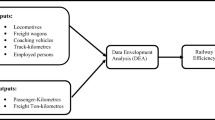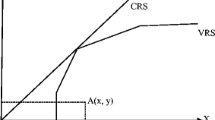Abstract
This study attempts to obtain efficiency scores of thirty-one railway companies operating worldwide by using data envelopment analysis. To assess the data covering a term from 2000 to 2009, we use CCR and BCC methods. According to the results of the CCR model analysis, 17 firms are found to have technical efficiency in the first year, whereas this figure goes up to 18 companies in the last year. Input oriented and variable return analysis in the concept of the BCC model, the number of the firms found technically efficient at the beginning of the period are 20. At the end of the period, this figure is up to 24. We implement panel regression analysis to estimate the effects of the companies’ output on their efficiency. Results imply that CCR models provide us more meaningful explanations. Malmquist Index analysis also indicates that total factor productivity increases by 0.03 % for the entire period.
Similar content being viewed by others
References
Atkinson SE, Cornwell C (1998) Estimating radial measures of productivity growth: frontier vs non-frontier approaches. J Prod Anal 10:35–46
Balgati BH (2008) Econometrics. Springer, Berlin
Banker RD, Charnes A, Cooper WW (1984) Some models for estimating technical and scale inefficiency in DEA. Manag Sci 30:1078–1092
Cantos P, Pastor JM, Serrano L (1999) Productivity efficiency and technical change in the European railways: a non-parametric approach. Transportation 26(4):337–357
Caves D, Christiensen LR, Diewert WE (1982) The economic theory of index numbers and the mesurement of input output and productivity. Econometrica 50:1393–1414
Charnes A, Cooper WW, Rhodes E (1978) Measuring the efficiency of decision making units. Eur J Oper Res 2:429–444
Charnes A, Cooper WW, Rhodes E (1979) Short communication: measuring the efficiency of decision making units. Eur J Oper Res 3(4):339
Coelli TA, Perelman S (1999) A comparison of parametric and non-parametric distance functions with application to European Railways. Eur J Oper Res 117:326–339
Cowie J (1999) The technical efficiency of public and private ownership in the rail industry: the case of Swiss. J Transp Econ Policy 33(3):241–252
Debreu G (1951) The coefficient of resource utilization. Econometrica 19(3):273–292
Duman İ (2006) Demiryollarının yeniden yapılanma ihtiyacı ve TCDD’deki gelişmeler. Uluslararası demiryolu sempozyumu bildiriler kitabı 2:13–15
Farrell MJ (1957) The measurement of productive efficiency. J R Stat Soc 120(3):253–281
Gujarati DN (2004) Basic econometrics. McGraw Hill, New York
Koopmans TC (1951) An analysis of production as an efficient combination of activities. In: Koopmans TC (ed) Activity analysis of production and allocation. Wiley, New Jersey
Lan LW, Lin ETJ (2006) Performance measurement for railway transport: Stochastic distance functions with inefficiency and ineffectiveness effects. J Transp Econ Policy 40(3):383–408
Liu FF, Wang PH (2008) DEA malmquist productivity measure: taiwanese semiconductor companies. Int J Prod Econ 112:367–379
Loizides J, Tsionas EG (2004) Dynamic distributions of productivity growth in European railways. J Transp Econ Policy 38(1):45–76
Malmquist S (1953) Indeks number and indifferences surfaces. Trabajos de Estatistica 4:209–242
Nashand ASJ, Nash CA (2010) Benchmarking of train operating firms: a transaction cost efficiency analysis. Transp Plan Technol 33(1):35–53
Sabri K, Colson GE, Mbangala AM (2008) Multiple criteria and multiple periods performance analysis: the comparison of North African railways. Computing anticipatory systems: CASYS’07-eighth international conference. AIP conference proceedings, vol 1051, pp 351–365
Şaşamaz Ç (2008) Karayollarında ve demiryollarında verimlilik analizi. Dissertation, Pamukkale Üniversitesi
TCDD (2011) Türkiye Cumhuriyeti Devlet Demiryolları istatistik yıllığı: 2006–2010. http://www.tcdd.gov.tr/Upload/Files/ContentFiles/2010/istatistik/20062010yillik.pdf. Accessed 01 February 2012
UIC (2011) Railway time-series data 1970–2009. http://www.uic.org/etf/publication/publication-detailphp?code_pub=302/70-09xl. Accessed 01 February 2012
Wang S, Liao C (2006) Cost structure and productivity growth of the Taiwan railway. Transp Res Part E 42:317–339
Yu M (2008) Assessing the technical efficiency service effectiveness and technical effectiveness of the world’s railways through NDEA analysis. Transp Res Part A 42:1283–1294
Author information
Authors and Affiliations
Corresponding author
Rights and permissions
About this article
Cite this article
Kabasakal, A., Kutlar, A. & Sarikaya, M. Efficiency determinations of the worldwide railway companies via DEA and contributions of the outputs to the efficiency and TFP by panel regression. Cent Eur J Oper Res 23, 69–88 (2015). https://doi.org/10.1007/s10100-013-0303-x
Published:
Issue Date:
DOI: https://doi.org/10.1007/s10100-013-0303-x




